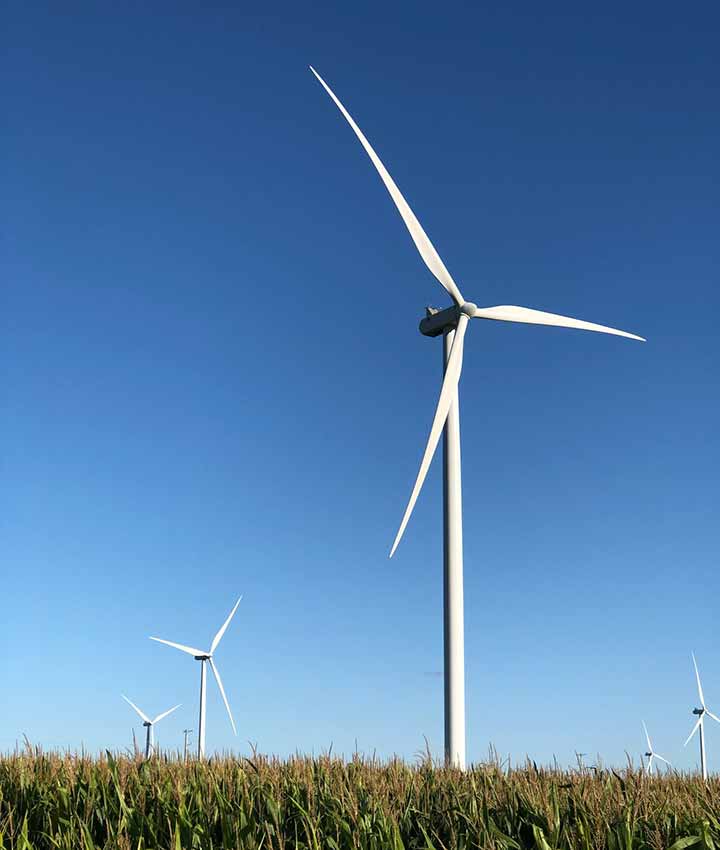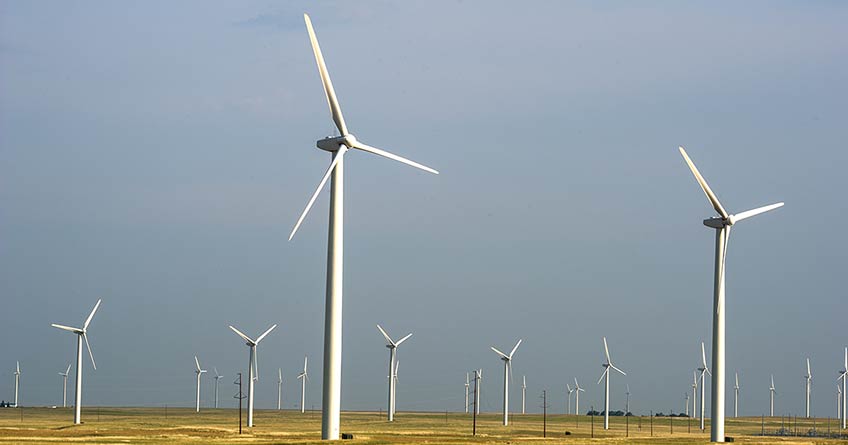The Leading Edge: January 2020 Wind Energy Newsletter
In this edition of The Leading Edge, a new open-source model helps improve wind power plant cost estimation and design, and we find out what happens when wind power sweeps into the community.
News Stories

When Wind Sweeps into Communities
Wind farm development in the United States often takes place in rural areas with property that is largely owned by farmers and ranchers who lease their land to developers. By the end of 2018, wind energy contributed 6.5% of the nation's electricity supply, with more than 30% in three states—Iowa, Kansas, and Oklahoma. With wind power capacity additions projected to continue growing, rural residents often wonder how wind energy will impact their communities. More to the point, they are interested to know if wind will be a good neighbor.
New Open-Source Model Works To Improve Wind Power Plant Cost Estimation and Design
Wind energy has the potential to become a major supplier of electricity in the United States, but significant cost and improvements in wind power technology are needed for that potential to become reality. That's where NREL's Land-based Balance of System Systems Engineering tool can help. This open-source tool, now publicly available, can help researchers, analysts, wind power developers, government agencies, and the public estimate the on-site balance-of-system costs associated with wind power plant construction.

Declining Renewable Costs Drive Focus on Energy Storage
Declining costs in available technologies have propelled interest in energy storage forward like never before. The price of lithium-ion batteries has fallen by about 80% over the past five years, enabling the integration of storage into solar power systems. Today, nearly 18% of all electricity produced in the United States comes from renewable energy sources, such as hydropower and wind—a figure that is forecast to climb. And as communities and entire states push toward higher percentages of power from renewables, there's no doubt storage will play an important role.
Downwind—In Case You Missed It
Published Resource To Enable Detailed Models for Entire Wind Plants
NREL researchers and other experts recently released a two-volume book that helps drive innovation to reduce the cost of wind energy for entire wind plants. Titled "Wind Energy Modeling and Simulation Volume 1: Atmosphere and Plant" and "Volume 2: Turbine and System," this resource addresses the challenges involved in creating predictive models for wind plant performance and the various disciplines required to solve it. Daily Energy Insider recently reported the publication in the article "NREL Researchers Publish Resources to Press Towards Detailed Wind Plant Models."
NREL Projects U.S. Offshore Wind Business Pipeline of $70 Billion by 2030
States all along the Eastern Seaboard are poised to join a renewable energy revolution that will not only provide clean electricity but also create tens of thousands of jobs, revitalize distressed port cities, and spur economic growth in dozens of coastal communities. Read the CNBC article "U.S. Has Only One Offshore Wind Energy Farm, but a $70 Billion Market Is on the Way" for more information. This potential is supported by an NREL report, which estimates that by 2027, New England could reach 144 gigawatts (GW) of offshore wind capacity, with Maine and Massachusetts leading the way at 65 GW and 55 GW, respectively.
What Oregon Offshore Wind Power Will Cost
The coast of Southern Oregon is well-suited to electrical generation from offshore wind and could be 30% to 40% less than previously estimated, a recent NREL study found. NREL researcher Walter Musial, the lead author of the study, was a guest recently on Southern Oregon University's Jefferson Public Radio, where he discussed the cost and feasibility of an offshore wind project in the area. Listen to the segment and read more in their article, "What Wind Power Will Cost off Oregon's Coast."
Publications
Estimation of Turbulence Dissipation Rate from Doppler Wind Lidars and in Situ Instrumentation for the Perdigão 2017 Campaign
Wind energy researchers need to understand the sources, spatial distribution, and temporal variability of turbulence in the atmospheric boundary layer. To improve turbulence-forcing process simulations, researchers need to observe turbulence in a broad range of terrain types and atmospheric conditions. In this study, the authors demonstrate a new approach for assessing the variability of turbulence parameters in a complex terrain by employing multiple instruments to provide a comprehensive view of turbulence structures and variability at the Perdigão 2017 field campaign.
Total Experimental Uncertainty in Hydrodynamic Testing of a Semisubmersible Wind Turbine, Considering Numerical Propagation of Systematic Uncertainty
Quantifying the uncertainty in experimental results is a critical step in properly validating numerical simulation tools for designing floating wind turbines. In this study, the authors tested a semisubmersible structure from the Offshore Code Comparison Collaboration, Continued, with Correlation study to better understand the hydrodynamic loading and assess the uncertainty. They found that the uncertainty in the low-frequency response metrics is most sensitive to the system properties and the wave elevation, which suggests that the underprediction of the low-frequency response behavior observed in previous validation studies is larger than the experimental uncertainty.
Classification of the Reynolds Stress Anisotropy Tensor in Very Large Thermally Stratified Wind Farms Using Colormap Image Segmentation
The characteristics of different types of turbulent flows have for many years been studied using a wide variety of approaches. However, interpretation and/or identification of the different turbulence states remains a challenging task, especially in regions where turbulence is not clearly identified with one of the idealized turbulence states. To overcome this limitation, the authors propose a technique that classifies states of turbulence anisotropy using an unsupervised learning procedure, which improved the identification of regions of the flow with similar turbulence characteristics. To illustrate the potential of this new technique, the authors present their results for a complex problem in which the turbulence structure of wind turbine wakes is analyzed as a function of thermal stratification.
Impact of Model Improvements on 80-m Wind Speeds during the Second Wind Forecast Improvement Project
The second Wind Forecast Improvement Project took place in Oregon and Washington from October 2015 through March 2018. The project aimed to improve the parameterizations within the High-Resolution Rapid Refresh model and its nested version, with the goal of increasing the forecast skill of wind turbine hub-height wind speeds. In this study, the authors use hub-height wind speed observations from sodars and profiling lidars to assess the impacts of the experimental parameterizations and finer horizontal grid spacing on the performance of High-Resolution Rapid Refresh and High-Resolution Rapid Refresh Nest models.
A Comparison of Classical and Aggregation-Based Algebraic Multigrid Preconditioners for High-Fidelity Simulation of Wind Turbine Incompressible Flows
Wind turbine simulations present two unique challenges for algebraic multigrid preconditioned solvers: the computational meshes include strongly anisotropic elements, and mesh motion requires matrix reinitialization and computational preconditioners of each time step. This article presents a comparison of parallel strong scaling performance of classical and aggregations algebraic multigrid preconditioners in the context of wind turbine simulations. Results show that faster time to solution is achieved by reducing preconditioner setup costs at the expense of linear-system solve costs.
Share

